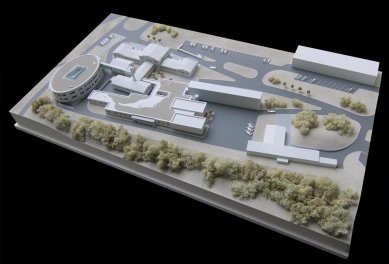
Prague's IKEM has started the construction of a new pavilion for 75 million
Prague - The Prague Institute of Clinical and Experimental Medicine (IKEM) officially began the construction of a new pavilion named Elipsa today, which will host scientific workplaces and laboratories. In the new spaces, experts will focus on researching stem cells for diabetes treatment, transplants, and finding functional liver replacements. The single-story building is expected to be completed in February 2014. This was announced to journalists by the hospital representatives.
IKEM was established in 1971 from six scientific medical institutes. It is now the largest healthcare clinical and research base in the Czech Republic. It focuses on the treatment of cardiovascular diseases, diabetes, and metabolic disorders, and performs transplants. It operates three centers - the Cardiocenter, the Transplant Center, and the Diabetes Center. It is complemented by the Center for Experimental Medicine (CEM), which concentrates research from all three centers and will be based in Elipsa. With the new building, IKEM aims to strengthen its research further.
"In a country where more than half of the population dies from circulatory diseases, where over a million people suffer from diabetes, and where transplants have become increasingly common in recent years, the existence of an experimental research base is an absolute necessity," said the head of CEM, Luděk Červenka.
In the laboratories of the new building, scientists will, for example, seek ways to obtain functional liver replacements, either as an organ or as tissue. They will focus on understanding the molecular mechanisms of liver regeneration. If the liver fails, it cannot yet be replaced by anything similar to hemodialysis for the kidneys. Other teams will focus on researching drugs for patients with heart failure or how stem cells could produce insulin. Research will also continue on the transplantation of Langerhans islets, a part of the pancreas. Current methods result in the loss of 50 to 60 percent of the transplanted tissue.
Pavilion Z7, or Elipsa, will be built in the lower part of the complex. The underground floor will contain garages, technical facilities, and storage, while the ground and first floors will house laboratories, administration, and a "genetic menagerie" for breeding laboratory rats and mice. The two-story building will have low energy consumption and will utilize natural light due to its glass roof.
According to IKEM Deputy Director Michal Stiborek, the work is expected to take 418 days. According to the plan, it should be completed by February 5, 2014. IKEM is financing the project with its own funds. The pavilion was originally planned to cost nearly 136 million crowns. However, the crisis has lowered construction prices, resulting in the project costing 75.4 million crowns, Stiborek added. Eight companies applied for the tender, and the contract was awarded to Metrostav. Payment will be made only after the construction is completed.
IKEM was established in 1971 from six scientific medical institutes. It is now the largest healthcare clinical and research base in the Czech Republic. It focuses on the treatment of cardiovascular diseases, diabetes, and metabolic disorders, and performs transplants. It operates three centers - the Cardiocenter, the Transplant Center, and the Diabetes Center. It is complemented by the Center for Experimental Medicine (CEM), which concentrates research from all three centers and will be based in Elipsa. With the new building, IKEM aims to strengthen its research further.
"In a country where more than half of the population dies from circulatory diseases, where over a million people suffer from diabetes, and where transplants have become increasingly common in recent years, the existence of an experimental research base is an absolute necessity," said the head of CEM, Luděk Červenka.
In the laboratories of the new building, scientists will, for example, seek ways to obtain functional liver replacements, either as an organ or as tissue. They will focus on understanding the molecular mechanisms of liver regeneration. If the liver fails, it cannot yet be replaced by anything similar to hemodialysis for the kidneys. Other teams will focus on researching drugs for patients with heart failure or how stem cells could produce insulin. Research will also continue on the transplantation of Langerhans islets, a part of the pancreas. Current methods result in the loss of 50 to 60 percent of the transplanted tissue.
Pavilion Z7, or Elipsa, will be built in the lower part of the complex. The underground floor will contain garages, technical facilities, and storage, while the ground and first floors will house laboratories, administration, and a "genetic menagerie" for breeding laboratory rats and mice. The two-story building will have low energy consumption and will utilize natural light due to its glass roof.
According to IKEM Deputy Director Michal Stiborek, the work is expected to take 418 days. According to the plan, it should be completed by February 5, 2014. IKEM is financing the project with its own funds. The pavilion was originally planned to cost nearly 136 million crowns. However, the crisis has lowered construction prices, resulting in the project costing 75.4 million crowns, Stiborek added. Eight companies applied for the tender, and the contract was awarded to Metrostav. Payment will be made only after the construction is completed.
The English translation is powered by AI tool. Switch to Czech to view the original text source.


0 comments
add comment










